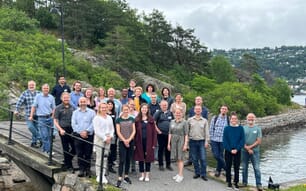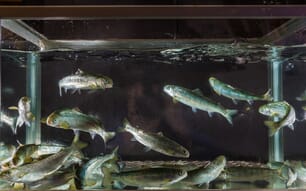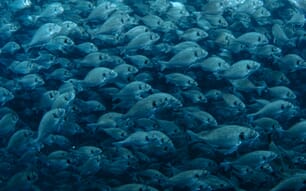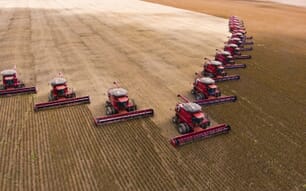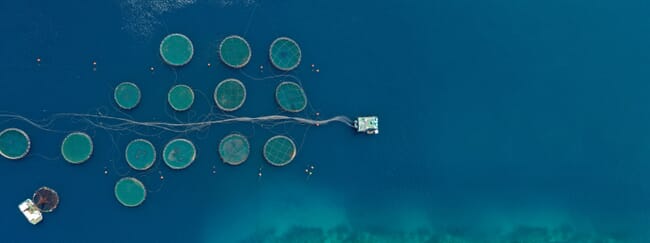
Given the predicted global population growth, the world needs more food, more proteins and more nutritious food. Undernutrition and malnutrition are significant challenges. Seafood is a natural part of a balanced and nutritious diet, and just over 3 billion people worldwide consume fish proteins as an essential part of their diet (FAO 2020).
At the same time, UN statistics show that less than 7 percent of all the proteins consumed by humans come from seafood. Of this, ocean-based seafood farming, including salmon, accounts for less than 1 percent. That means that more than 95 percent of the protein that we eat in the world is produced on land or in fresh water.
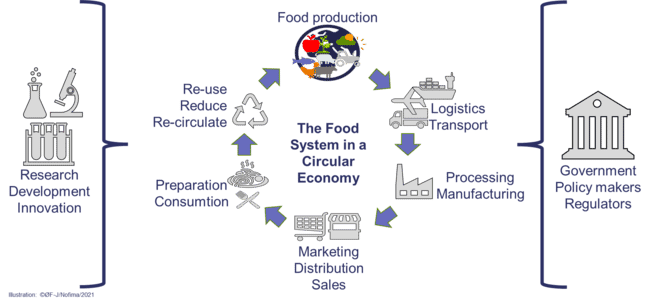
Global food production is a significant source of greenhouse gas emissions. When the entire land-based food system is included – from production to consumer – it accounts for as much as a third of all man-made greenhouse gas emissions, according to the UN Intergovernmental Panel on Climate Change (ICCP 2019). The percentage produced by intensive animal husbandry and deforestation to develop new cultivation and grazing areas is 16 – 27 percent, while emissions that occur during transport and processing after the raw materials are produced amount to 5-10 percent. In total, land-based food systems account for 21– 37 percent of all man-made greenhouse gas emissions. In addition, according to the IPPC report, a quarter of all the food produced on land never reaches our stomachs, but is wasted.
In the future, seafood and aquaculture must participate in the development of food systems from both sea and land with lower greenhouse gas emissions and less food waste. This is also documented in a recently published by The Blue Food Assessment (BFA), an international joint initiative representing over 100 scientists from more than 25 institutions. The Stockholm Resilience Centre and Stanford University are the lead science partners and EAT-Foundation is the lead impact partner.
Worldwide, marine aquaculture is a marginal producer of proteins, but it has a strong basis for taking on a much larger and more significant role. The Norwegian aquaculture industry has technology and knowledge that can contribute to achieving the major global food security goals. We also know that the blue food system results in lower greenhouse gas emissions and requires fewer freshwater resources, which is the number one scarcity factor for growth in land-based food production (Figure 2).

© ICPP, Climate Change and Land, 2019
The challenges related to the way we produce food and what we eat point out that there needs to be a change in diet. Plant-based food is on the rise but will certainly not be the only solution. More food must be produced and harvested from the ocean and, if possible, at a lower trophic level. As 90 percent of the energy is lost at each trophic level of the food chain, the lower down in the food-chain food is harvested, the more resource efficient it will be. Changing the diet to include more plant-based food and more seafood can help reduce global greenhouse gas emissions.
The UN’s High-Level Panel for a Sustainable Ocean Economy points out that there are good solutions for reducing greenhouse gas emissions by harvesting and producing more food in the ocean. One of the five proposed areas to reduce the climate impact from food production is to change diet by eating more seafood. This would contribute to as much as 25 percent of greenhouse gas reductions from the oceans by 2030 (Figure 3). In this context, seafood is defined to include wild-caught fish and low-trophic aquaculture, such as kelp and sea urchins.
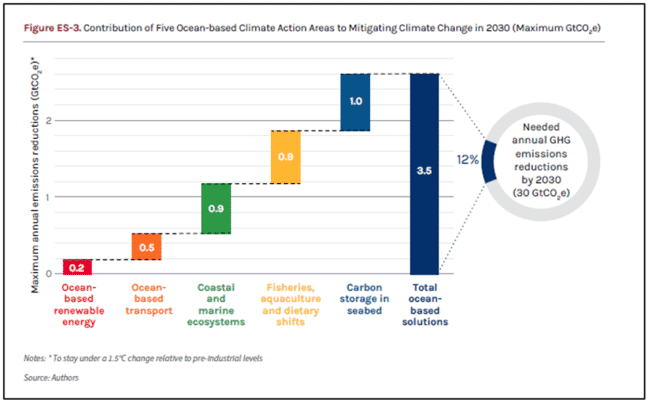
Figure 3; Contribution of seafood and changes in diet to cuts in greenhouse gas emissions. © The UN’s High-Level Panel for a Sustainable Ocean Economy, ‘The Ocean as a Solution to Climate Change’, 2019
According to the FAO, more than 90 percent of the world’s wild fish stocks are either fully exploited or overexploited. Therefore, the greatest opportunity to increase available seafood from the fisheries is to cut waste and utilise by-catch for protein production. The blue food system must be circular, and resources must not be thrown away, but reused in a good way.
Based on research and innovative solutions, we are becoming increasingly good at safeguarding residual raw materials from bycatches and the seafood processing industry to use in protein products, fats, minerals and special fractions that can be used in food products in a circular bioeconomy. Nofima’s research helps to develop kelp into food, utilise residual raw materials such as bones from the cod fisheries and utilise residual raw materials from mackerel, to name just a few.
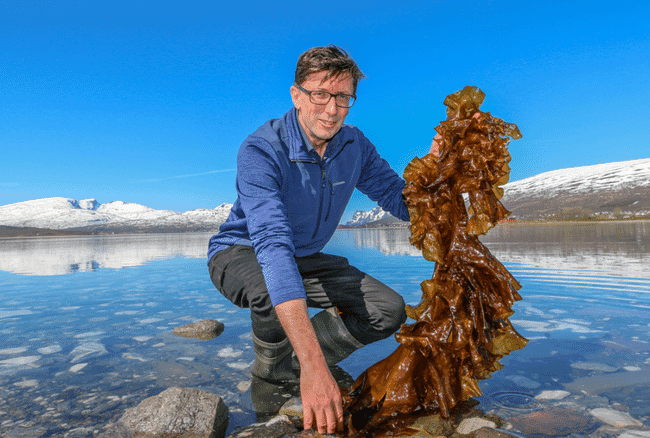
© Emil Bremnes, Nofima
At the same time, we must be aware of consumer trends that seem to show that many environmentally engaged consumers do not want to eat wild fish to protect particularly vulnerable stocks. As a result, a new industry is emerging. A number of companies are developing “seafood” made from plants and algae, or with the help of cell cultivation and fermentation. Several markets offer plant-based alternatives to special species of fish, such as tuna and eels, and companies like BluNalu and Shiok Meats are developing products using cell-based aquaculture. Trends show that not only hamburgers and meat are being replaced with plant-based and cultivated alternatives, but also fish.
Aquaculture’s unfulfilled potential
Worldwide, aquaculture is the food production method that has increased the most since 2010, with an annual growth of more than 5 percent in volume. Aquaculture is also highlighted as the part of the seafood industry that really has the potential to grow in a sustainable way, being a part of the solution for providing more high-quality protein to an increasing population. Quality research and innovation can help to remove bottlenecks and fully utilise the opportunities found in a sustainable food system where aquaculture plays an important global role.
Sustainable feed is the most important input. Feed accounts for the significant portion of production cost and climate footprint in fish aquaculture. In addition, the climate footprint of feed raw materials is of great importance for the total greenhouse gas emissions in the production of farmed fish. Aquaculture is part of a complex food system that includes oceans and land, and we must have knowledge about all aspects to make informed choices when choosing which new feed ingredients to focus on. Aquafeed Technology Centre (ATC) is a national infrastructure platform led by Nofima. ATC has state-of-the-art equipment that is used to research processing, the technical and physical properties a new feed ingredient must have to succeed as a fish feed raw material.
Through feed raw materials, fish farming has a golden opportunity to develop circular food systems that include both land and sea. Therefore, we must also be able to compare the climate/environmental footprints of different resources for producers and consumers to make knowledge-based climate-friendly choices.
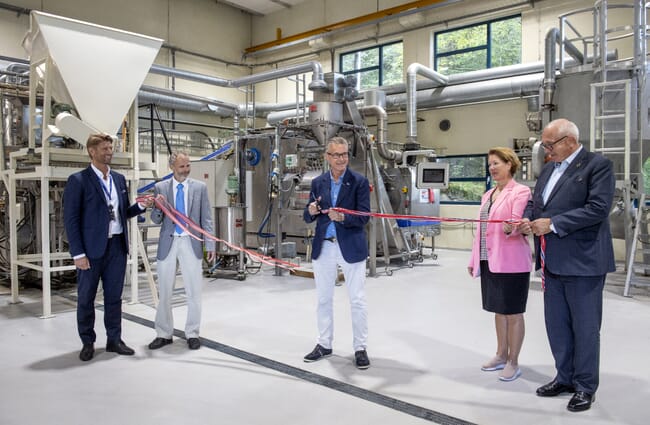
Protein resources in feed are utilised more efficiently in farmed fish compared to production animals on land. This is due to basic biology – fish are poikilothermic and do not use their energy to maintain a constant body temperature, nor do they need to use energy against gravity to stay upright. At the same time, protein utilisation is affected by how much of the animal is eaten. A chicken has a low FCR and much of the animal is utilised for food, meaning that it now has a quite similar protein utilisation to salmon, when calculated per edible portion weight. The goal of circular food systems is that all resources are utilised, and fully utilising resources will naturally have a positive effect on the utilisation of valuable feed resources for all animals in future food systems.
Breeding programmes are an effective way to increase the productivity of aquaculture and at the same time solve challenges such as losses caused by disease and developmental problems. Unlocking the animal’s genetic potential for growth and health through breeding is well documented, yet less than 20 percent of farmed aquatic species are in systematic breeding programmes worldwide.
A diversification of species in aquaculture is necessary to increase aquaculture’s contribution to the world’s food security, and all new species that are to be farmed must be domesticated. Targeted breeding programmes for new species is the solution. These involve costly investments that will often require the public and private sectors to join forces. During early stages that involve great uncertainty, public investment will reduce risks and therefore enable the commercial development of new species. This was the case for Atlantic salmon, the GIFT strain of tilapia and now with Atlantic cod, for which Nofima heads the national breeding programme.
A global increase in seafood also requires more space
But where can we find new areas for a growth in production? Technological developments are significant, and provide opportunities to move aquaculture production on land, enclose it inside semi-closed facilities along the coast and move it further out to sea. However, development must take place on the fish’s terms and be adapted to the animal’s biology. To succeed, we must ensure that the health and welfare of fish are safeguarded in all types of production systems and in all phases of their lives. Nofima has conducted broad research activity into fish welfare and contributes knowledge about fish welfare in closed and semi-closed fish farming systems, especially in the CtrlAqua Centre for Research-based Innovation.
At the same time, the seafood industry must be at the forefront and be aware of the consequences that climate change can have for the environment along the coast and for fish farming sites. These include changes in temperature, acidification, oxygen, extreme weather conditions and, in turn, changed environmental conditions that can provide good conditions for pathogenic agents. Nofima contributes knowledge about how fish farming can prepare itself for the effects of climate change through research in the EU project called ClimeFish and breeding research on climate-robust salmon.
Conclusions
To be successful in achieving the objectives of the green shift, greenhouse gas emissions from food systems must be significantly reduced. The oceans and seafood are key actors in reducing greenhouse gas emissions and producing more food at the same time. We as stakeholders in aquaculture can contribute a lot by sharing knowledge and technology to increase seafood production around the world. That is a good thing. However, we have only just begun the job of transforming the global food system. It is not obvious that seafood and aquaculture will get a significant place at the table. We must build knowledge and actively share it internationally to succeed.
* This topic is set to be a key theme at Aquaculture Europe 2021, which is organised by the European Aquaculture Society and will take place in Funchal, Madeira on 4-7 October.

